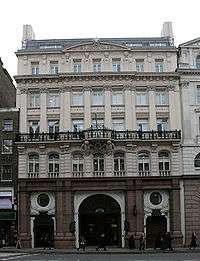Outer Temple
The Outer Temple is thought to have been one of the ten Inns of Chancery. Previously unknown, its existence was first posited by A. W. B. Simpson and confirmed by John Baker in 2008. Little is known of it, other than that it lacked a hall; Baker suggests that this is the reason that it did not survive long enough to appear in many records.
History
It is believed that the Inns of Chancery evolved in tandem with the Inns of Court. During the 12th and 13th century the law was taught in the City of London, primarily by the clergy. During the 13th century two events happened which destroyed this form of legal education – firstly a papal bull in 1218 that prohibited the clergy from teaching the law, and secondly decrees by King Henry II and Henry III that no institutes of legal education could exist in the City of London[1][2] As a result, the system of legal education fell apart, and the lawyers instead settled immediately outside the City of London as close as possible to Westminster Hall, where the Magna Carta provided for a permanent court. This was the small village of Holborn, where they inhabited "hostels" or "inns", which later took their name from the landlord of the Inn in question.[1]
After the Temple was confiscated from the Knights Templar in 1312, King Edward II divided it between the Inner Temple and Outer Temple, being the parts of the Temple within and without the boundaries of the City of London. (The Inner Temple was in turn divided in two in 1337, the eastern part continuing to be called Inner Temple and the western part becoming known as Middle Temple. They were each leased to lawyers in 1346.)[3]
Although the Outer Temple was an Inn of Chancery in the time of John Fortescue (died c.1480), little is known of it; it certainly lacked a hall, which Baker suggests is the reason that it did not survive past the 16th century.[4]
Discovery
While John Fortescue wrote of ten Inns of Chancery, each one attached to an Inn of Court "like Maids of Honour to a Princess",[5] only nine were previously known.[6] The existence of the tenth, Outer Temple, was first suggested by A. W. B. Simpson, who discovered a reference to a barrister named William Halle in the year books of the Serjeants-at-Law who was said to have come from the Outer Temple. At the time, Simpson debated whether it was a reference to a historical institution or simply a geographical address. In 2008 John Baker confirmed that it was most likely an institution with a discovery in the plea rolls of the Court of King's Bench of a barrister who claimed to be a "fellow of the [Outer] Temple".[7] In 2013 John Baker discovered another member of the Outer Temple, Richard Palmer, who was sued in the Court of Common Pleas in 1523 and described as of the Exterior or Outer Temple, London.[8]
Present-day chambers

There is a 19th-century building called "The Outer Temple", situated between Strand and Essex Court/Brick Court (of the Middle Temple),[9] just outside the Middle Temple boundary in the City of Westminster, and directly opposite the Royal Courts of Justice. It is occupied by barristers (as well as a branch of a retail bank) but is not directly related to the historic Outer Temple.
In fiction
Horace Rumpole, the fictional barrister creation of John Mortimer, QC, claims to have eaten his dinners at the Outer Temple; Mortimer trained at the Inner Temple.
References
Bibliography
- Baker, John (2008). "The Inn of the Outer Temple". Law Quarterly Review. Sweet & Maxwell (124). ISSN 0023-933X.
- Baker, John (2013). Collected Papers on English Legal History. Cambridge University Press. ISBN 9781107020436.
- Bellot, Hugh (1902). The Inner and Middle Temple. London: Methuen & Co.
- Loftie, W J (1895). The Inns of Court and Chancery. New York: Macmillan & Co. OCLC 592845.
- Watt, Francis; Dunbar Plunket Barton; Charles Benham (1928). The Story of the Inns of Court. Boston: Houghton Mifflin. OCLC 77565485.
Coordinates: 51°30′48″N 0°06′45″W / 51.5133°N 0.1126°W